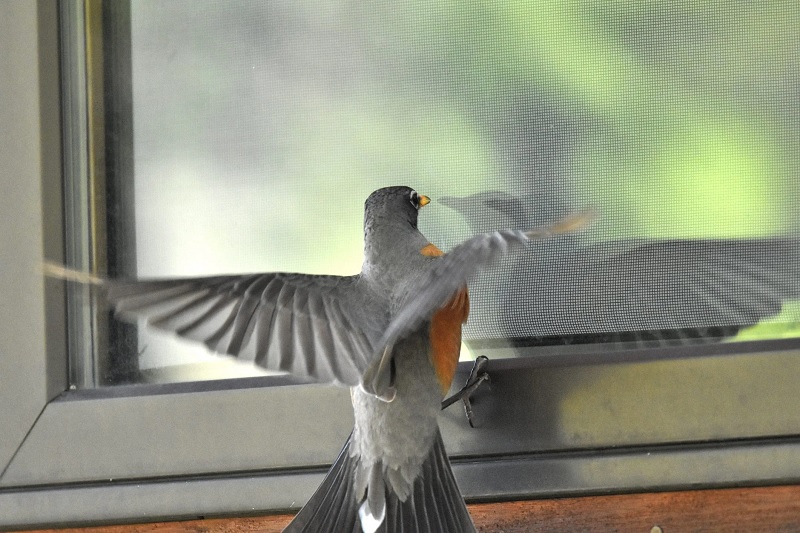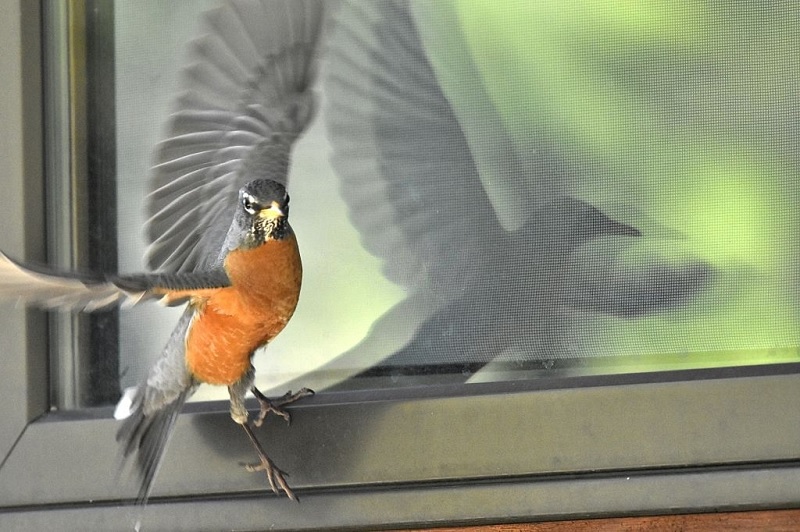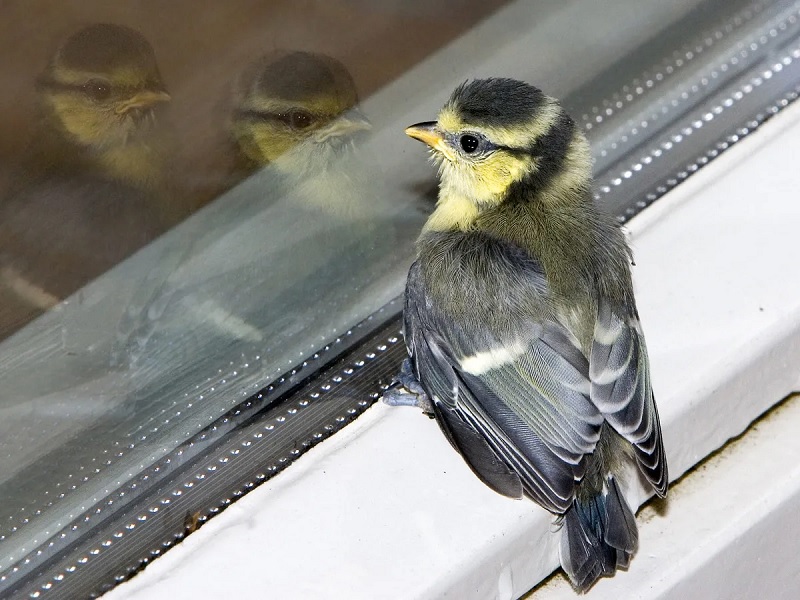Have you ever noticed a bird fluttering frantically in front of a mirror or window, pecking or flapping its wings in distress? It’s not just a quirky behavior—it’s a real problem. If you’ve ever wondered why are mirrors bad for birds, the answer lies in how birds perceive reflections. Unlike humans, birds don’t understand that a mirror shows an image of themselves. Instead, they see what they believe to be another bird intruding on their territory.
This can trigger aggressive or anxious reactions, leading to exhaustion, stress, and even physical injury. Mirrors in homes, gardens, or even on cars can unknowingly become hazards for our feathered friends. As urban spaces expand, these reflective surfaces are becoming more common, increasing risks for birds. Understanding why are mirrors bad for birds helps us take simple, mindful steps to make environments safer for them—because a small change in our surroundings can make a big difference in theirs.
How Birds Perceive Reflections
Understanding how birds perceive reflections is key to explaining their unusual and sometimes dangerous behavior around mirrors and windows. While humans quickly learn that a reflection is just an image, birds process these visual cues very differently. The reflective surface may seem harmless to us, but to a bird, it can be confusing, threatening, or even life-threatening. Let’s break down the two main reasons birds react strongly to their own reflections.

Lack of Self-Recognition
Most birds lack the cognitive ability to recognize themselves in a mirror. While some highly intelligent species like magpies and certain parrots have shown signs of self-recognition in controlled studies, the vast majority of birds cannot make the connection. When they see their reflection, they don’t understand that it’s just an image—they believe it’s another bird.
This inability to distinguish between self and reflection can cause a bird to behave in ways that seem strange or erratic. They might repeatedly peck at a mirror, flutter aggressively, or even try to “interact” with the image. These actions can lead to unnecessary stress, physical exhaustion, and injury, especially if the bird continues the behavior for hours or days.
Mistaking Reflections for Rivals
One of the most common reactions birds have to their reflection is territorial aggression. During breeding season or while defending nesting areas, many bird species become particularly territorial. When they see their reflection, they interpret it as an intruding rival bird threatening their space.
This can provoke intense defensive behavior. A bird may dive-bomb the mirror, attack it with its beak, or hover in front of it for extended periods, trying to drive the “intruder” away. In some cases, birds have been known to injure themselves by repeatedly crashing into windows or mirrors.
What makes this more concerning is that the reflection doesn’t respond or retreat, which reinforces the bird’s need to “fight” harder. This can lead to ongoing stress and potential physical harm. Over time, this repeated behavior can affect a bird’s health, energy levels, and ability to care for its young.
Behavioral Impacts of Mirrors on Birds
While mirrors might seem like a harmless household feature, they can significantly affect a bird’s behavior in unexpected and sometimes harmful ways. Birds interact with mirrors not for entertainment or curiosity, but often out of confusion or perceived threat. Without the ability to recognize themselves, their reactions to reflections can trigger a cascade of stress-related behaviors. Below are the key behavioral impacts that mirrors can have on birds.

Increased Aggression
Attacking the Mirror
One of the most immediate reactions birds have to a mirror is aggressive behavior. When a bird sees its reflection, especially during mating or nesting season, it often interprets the image as a rival bird invading its territory. This can result in repeated attacks on the mirror, including pecking, clawing, and even flying into it.
These confrontations can be intense and prolonged. Since the “intruder” in the mirror never backs down, the bird’s instinct tells it to keep fighting. Over time, this behavior can lead to physical injuries such as damaged beaks, feathers, or wings. It’s not uncommon for birds to wear themselves out trying to drive away what they believe is a persistent enemy.
Territorial Stress
The illusion of an ever-present rival also causes ongoing territorial stress. Many bird species, such as robins and cardinals, are extremely territorial, especially during breeding season. When they can’t “win” the fight against the mirror image, it results in chronic stress and anxiety. The bird remains in a heightened state of alertness, wasting valuable energy and risking its overall health. Prolonged stress can weaken their immune system, affect their ability to reproduce, and ultimately reduce their survival chances.
Repetitive and Obsessive Behaviors
Another impact of mirror exposure is the development of repetitive and obsessive behaviors. Some birds may become fixated on the mirror, returning to it constantly throughout the day. They might spend hours perching in front of the reflective surface, singing, tapping, or fluttering their wings in a loop of compulsive behavior.
This obsessive interaction can crowd out other normal, healthy activities. It becomes a cycle that the bird cannot break, driven by the mistaken belief that the reflection is a real, reactive presence. This behavior is not only mentally exhausting for the bird but can also lead to chronic stress and long-term behavioral issues.
Disruption of Normal Activities
Reduced Eating and Sleeping
Mirror-induced stress or obsession can interfere with basic survival behaviors like eating and sleeping. Birds that are preoccupied with their reflection may ignore food altogether, especially if the mirror is placed near feeding areas. This leads to reduced nutrient intake, weakness, and in severe cases, malnutrition.
Likewise, the stress or constant engagement with the mirror can disrupt a bird’s sleep patterns. Instead of resting during nighttime or quiet hours, a bird might stay alert and agitated, reacting to the reflection even in low light. Poor sleep negatively affects their physical health, mood, and immune response.
Ignoring Social Interactions
For birds that live in flocks or in pairs, mirrors can interfere with natural social behavior. A bird may become so engrossed with its reflection that it ignores its real companions. This can create social tension, isolation, or even aggression within a group of birds.
In pet birds, especially parrots or budgies, this can also affect bonding with their human caregivers. A bird might start preferring interaction with its reflection over people or other birds, missing out on healthy, enriching interactions that are essential for its mental and emotional well-being.
Health Consequences of Mirror Exposure
While the behavioral changes caused by mirror exposure in birds are concerning on their own, the health consequences can be even more severe. What starts as confusion or territorial aggression can quickly spiral into physical harm and long-term health issues. Understanding how mirrors impact birds on a physical and psychological level is essential for preventing unintended suffering.

Physical Injury
One of the most immediate risks of mirror exposure is physical injury. Birds often attack their reflection, mistaking it for a rival. These attacks may involve pecking, scratching, or even flying directly into the mirror. Since the reflected “opponent” never retreats, the bird continues its assault, sometimes for hours or days.
This behavior can result in a range of injuries, including bruised or broken beaks, feather loss, wing damage, or even concussions. In severe cases, repeated collisions with hard reflective surfaces can be fatal. These injuries not only cause pain but can also hinder a bird’s ability to eat, fly, or protect itself in the wild.
Chronic Stress and Fatigue
Beyond visible injuries, constant exposure to mirrors can trigger chronic stress. Birds become mentally overwhelmed by the “presence” of what they believe is a competitor. This leads to prolonged periods of alertness, aggression, and agitation.
Over time, this heightened stress state depletes their energy reserves and weakens their immune system. Fatigue sets in as birds spend more time obsessing over the reflection and less time resting, feeding, or engaging in normal behaviors. In wild birds, this can affect their ability to migrate, breed, or escape predators. In captive birds, it can lead to a range of stress-related health problems, such as feather plucking or refusal to eat.
Long-Term Psychological Effects
Long-term exposure to mirrors doesn’t just impact a bird’s body—it can also alter its mental well-being. Repeated confusion and frustration caused by interacting with a reflection may lead to long-term psychological changes. Birds may develop obsessive behaviors, like constantly returning to the mirror, or display signs of depression and withdrawal when the mirror is removed.
Impact on Pet Birds vs. Wild Birds
Mirrors can affect all birds, but the consequences differ depending on whether the bird lives in a cage or in the wild. Both pet birds and wild birds respond to reflections with confusion or stress, but the environment they live in plays a big role in how those responses affect their health and behavior. Understanding the difference helps us take the right steps to protect both.
Pet Birds and Mirrors in Cages
Many pet owners place mirrors inside bird cages with the assumption that it will provide companionship or entertainment. However, this can actually be harmful. Most pet birds—especially parrots, budgies, and cockatiels—don’t recognize their reflection as themselves. Instead, they believe it’s another bird.
This leads to confusing and often obsessive behavior. A pet bird may try to communicate, feed, or even bond with the reflection. Over time, this can cause emotional distress and social confusion. The bird might become overly attached to the mirror, ignoring its human caregivers or any real bird companions. In some cases, birds may act aggressively toward their reflection, pecking at it repeatedly and causing injury or stress.
Mirrors can also interfere with a bird’s mental stimulation and enrichment. Instead of exploring toys, engaging with their owner, or foraging, a bird may spend hours fixated on the mirror. This lack of variety and interaction can lead to boredom, behavioral problems, and even depression in pet birds.
Wild Birds and Reflective Surfaces Outdoors
In the wild, birds encounter mirrors in the form of windows, car mirrors, building glass, and shiny objects like chrome or solar panels. These reflections can trigger aggressive territorial behavior, especially during breeding season when birds are more likely to defend their space.
When a wild bird sees its reflection, it often thinks it’s facing a rival. This can lead to repeated attacks on the surface, with birds pecking, flapping, or flying into windows or mirrors. These behaviors can result in serious injuries or death. Even if they survive, the energy spent on defending their territory from a nonexistent threat takes away from essential activities like foraging, nesting, and caring for young.
In urban and suburban areas where reflective surfaces are more common, this problem is especially widespread. Fortunately, simple steps—like using decals, non-reflective films, or covering car mirrors—can significantly reduce these risks.
Ethical Considerations and Best Practices
As our understanding of bird behavior grows, so does our responsibility to ensure that the environments we create—both in captivity and in the wild—support their physical and mental well-being. One of the most overlooked aspects of bird care is the presence of mirrors. While they might seem harmless or even entertaining, mirrors can cause confusion, stress, and long-term harm. This raises important ethical questions and calls for mindful choices. Below are some best practices to help create healthier, more supportive environments for birds.
Should Mirrors Be Removed from Bird Cages?
Yes—unless recommended by an avian behaviorist, mirrors should generally be removed from bird cages. While they may provide temporary fascination, they often lead to unhealthy behavior patterns. Birds that cannot recognize themselves in the reflection may treat the image as a companion or rival, which can create emotional confusion, obsessive fixation, or aggressive responses.
Some pet owners notice that their bird “talks to” or “feeds” the mirror. While this may seem cute, it’s actually a sign of a bird misreading social cues, which can result in frustration, isolation, and even depression. In extreme cases, the bird may bond exclusively with the mirror and become withdrawn from human interaction or other birds.
Removing mirrors from cages is an ethical choice that prioritizes a bird’s natural behaviors and mental health. It allows space for genuine interaction, exploration, and engagement with their real environment.
Alternatives to Mirrors for Stimulation
The good news is that there are plenty of healthy, enriching alternatives to mirrors that can provide mental stimulation and entertainment for pet birds. One excellent option is foraging toys, which encourage natural behaviors like searching, exploring, and problem-solving. By hiding treats inside puzzle toys, paper rolls, or shreddable materials, you can keep your bird mentally and physically active, mimicking the experience of searching for food in the wild.
Another helpful strategy is rotating toys. Birds, much like humans, can get bored of the same surroundings day after day. By switching out their toys regularly or rearranging their cage setup, you create a new environment that sparks curiosity and encourages exploration. This simple change can go a long way in preventing boredom and behavioral issues.
Engaging in interactive play is also a powerful alternative to mirror stimulation. Spend time talking, singing, or playing gentle games with your bird. These authentic social interactions help build trust and companionship, offering mental and emotional enrichment that a mirror simply can’t provide.
Providing natural perches and climbing structures—such as branches, ropes, ladders, or swings—gives your bird an opportunity to climb, balance, and explore. These additions closely mimic a more natural habitat and support physical health, dexterity, and mental stimulation.
Frequently Asked Questions
Why Are Mirrors Bad for Birds?
Mirrors can be misleading and even harmful to birds because they do not recognize their reflection as themselves. Instead, they often interpret the reflection as another bird—either a potential mate or a rival. This misunderstanding can lead to obsessive behavior, territorial aggression, stress, and in some cases, physical injury. A bird may spend excessive time interacting with its reflection, neglecting essential activities like eating, resting, or socializing. Over time, this can negatively impact its health and overall well-being.
Can Mirrors Cause Stress in Pet Birds?
Yes, mirrors can cause significant stress in pet birds. When a bird sees its reflection, it may react defensively or become overly attached, depending on how it interprets the image. In either case, the bird’s mental state can suffer. If it thinks the reflection is a rival, it may show aggression, constantly peck at the mirror, or stay in a heightened state of anxiety. If it sees the reflection as a companion, it may bond with it and become distressed when the “companion” doesn’t respond appropriately.
Do Birds Recognize Themselves in Mirrors?
Most birds do not recognize themselves in mirrors. Only a few highly intelligent species—like magpies and some parrots—have shown signs of self-recognition in scientific studies. The majority of birds see their reflection as another bird, which leads to confusion. This lack of recognition is why birds react so strongly to mirrors, often treating them as if another bird is invading their space or ignoring their social cues.
Are Mirrors Safe for Wild Birds?
No, mirrors and other reflective surfaces can pose serious dangers to wild birds. Outside, birds may mistake reflections in windows, car mirrors, or shiny objects for open sky or another bird. This can cause them to repeatedly attack the surface or fly into it at full speed, leading to injury or even death. During breeding season, territorial birds like robins and cardinals are especially prone to attacking reflections, thinking they are protecting their territory from a rival.
Should You Remove Mirrors from Bird Cages?
Yes, it’s generally a good idea to remove mirrors from bird cages, especially for birds that show signs of obsession or aggression toward their reflection. While some pet owners believe mirrors offer companionship, they often cause more harm than good. Instead of helping your bird feel less lonely, mirrors can create emotional confusion, lead to behavioral problems, and interfere with real social bonding—with either humans or other birds.
What Are Better Alternatives to Mirrors for Bird Enrichment?
Instead of mirrors, you can provide your bird with mentally stimulating toys and activities that promote natural behaviors. Foraging toys, climbing structures, rotating perches, and interactive play sessions are great ways to keep your bird engaged. Social interaction—either with you or another compatible bird—offers the emotional connection birds truly need. These alternatives are safer and more enriching, supporting both your bird’s physical and mental health.
Conclusion
Mirrors may seem harmless or even entertaining, but for birds, they often cause confusion, stress, and harm. Because most birds cannot recognize their own reflection, they mistake it for a rival or potential mate, leading to aggressive or obsessive behaviors. These reactions can result in physical injuries, chronic stress, and disruption of natural activities like eating and socializing.
Whether in pet cages or wild environments, mirrors and reflective surfaces pose real risks to birds’ well-being. By understanding why are mirrors bad for birds, you can take simple yet effective steps—such as removing mirrors from cages and reducing reflective hazards outdoors—to protect their health and happiness. Creating safer spaces helps ensure birds thrive, free from unnecessary stress and danger.
